Morpho-Biochemical Modification of Petunia to Saline Water and Salicylic Acid Applications
Abstract
1. Introduction
2. Materials and Methods
2.1. Experimental Setup
2.2. Data Recorded
2.3. Vegetative and Flowering Attributes
2.4. Physiological and Chemical Analysis
2.5. Statistical Analysis
3. Results
3.1. Growth Attributes
3.2. Flowering Attributes
3.3. Chlorophyll
3.4. Proline
3.5. Mineral Composition
4. Discussion
5. Conclusions
Author Contributions
Funding
Data Availability Statement
Acknowledgments
Conflicts of Interest
References
- Fernández García, I.; Lecina, S.; Ruiz-Sánchez, M.C.; Vera, J.; Conejero, W.; Conesa, M.R.; Domínguez, A.; Pardo, J.J.; Léllis, B.C.; Montesinos, P. Trends and challenges in irrigation scheduling in the semi-arid area of Spain. Water 2020, 12, 785. [Google Scholar] [CrossRef]
- Murtaza, G.; Zia-ur-Rehman, M.; Rashid, I.; Qadir, M. Use of Poor-Quality Water for Agricultural Production. In Research Developments in Saline Agriculture; Dagar, J.C., Yadav, R.K., Sharma, P.C., Eds.; Springer: Singapore, 2019; pp. 769–783. ISBN 9789811358326. [Google Scholar]
- Elhindi, K.M.; Al-Mana, F.A.; Algahtani, A.M.; Alotaibi, M.A. Effect of irrigation with saline magnetized water and different soil amendments on growth and flower production of Calendula officinalis L. plants. Saudi J. Bio. Sci. 2020, 27, 3072–3078. [Google Scholar] [CrossRef] [PubMed]
- Anny Mrudhula, K.; Venkata Subbaiah, G.; Sambaiah, A.; Sunil Kumar, M. Performance of flower and medicinal plants with saline irrigation water through drip system. Pharma Innov. J. 2021, 10, 1514–1519. Available online: https://www.thepharmajournal.com/archives/2021/vol10issue8/PartU/10-7-439-247.pdf (accessed on 23 July 2021).
- Banon, D.; Lorente, B.; Ortunõ, M.F.; Bañon, S.; Sanchez-Blanco, M.J.; Alarcon, J. Effects of saline irrigation on the physiology and ornamental quality of Euphorbia Ascot Rainbow and its relationship with salinity indexes based on the bulk electrical conductivity. Sci. Hort. 2022, 305, 111406. [Google Scholar] [CrossRef]
- El-Banna, M.F.; AL-Huqail, A.A.; Farouk, S.; Belal, B.E.A.; El-kenawy, M.A.; Abd El-Khalek, A. Morpho-physiological and anatomical alterations of salt-affected thompson seedless grapevine (Vitis vinifera L.) to brassinolide spraying. Horticulturae 2022, 8, 568. [Google Scholar] [CrossRef]
- Farouk, S.; AL-Huqail, A.A. Sustainable biochar and/or melatonin improve salinity tolerance in borage plants by modulating osmotic adjustment, antioxidants, and ion homeostasis. Plants 2022, 11, 765. [Google Scholar] [CrossRef]
- Mahdavian, K. Effect of salicylic acid and calcium chloride on lipid peroxidation and scavenging capacity of radical of red bean (Phaseolus calcaratus L.) under salt stress. Int. J. Hortic. Sci. Technol. 2022, 9, 55–72. [Google Scholar]
- Sousa, V.F.O.; Santos, A.S.; Sales, W.S.; Silva, A.J.; Gomes, F.A.L.; Dias, T.J.; Gonçalves-Neto, A.C.; Faraz, A.; Santos, J.P.O.; Santos, G.L.; et al. Exogenous application of salicylic acid induces salinity tolerance in eggplant seedlings. Braz. J. Biol. 2024, 84, e257739. [Google Scholar] [CrossRef]
- Farouk, S.; Arafa, S.A. Mitigation of salinity stress in canola plants by sodium nitroprusside application. Span. J. Agric. Res. 2018, 16, e0802. [Google Scholar] [CrossRef]
- El-Taher, A.M.; Abd El-Raouf, H.S.; Osman, N.A.; Azoz, S.N.; Omar, M.A.; Elkelish, A.; Abd El-Hady, M.A.M. Effect of salt stress and foliar application of salicylic acid on morphological, biochemical, anatomical, and productivity characteristics of cowpea (Vigna unguiculata L.) plants. Plants 2022, 11, 115. [Google Scholar] [CrossRef]
- Ashraf, K.; Siddiqi, E.H.; Bhatti, K.H.; Iqbal, I.; Nasir, M.; Hassan, A.; Aslam, K.; Mehmood, S. Role of salicylic acid in the alleviation of salt stress on pea cultivars using growth, biochemical and physiological attributes. GU J. Phytosci. 2023, 3, 94–101. [Google Scholar] [CrossRef]
- Fouad, A.; Hegazy, A.E.; Azab, E.; Khojah, E.; Kapiel, T. Boosting of antioxidants and alkaloids in Catharanthus roseus Suspension cultures using silver nanoparticles with expression of CrMPK3 and STR genes. Plants 2021, 10, 2202. [Google Scholar] [CrossRef] [PubMed]
- Cassaniti, C.; Romano, D.; Flowers, J.T. The response of ornamental plants to saline irrigation water. In Irrigation-Water Management, Pollution and Alternative Strategies; Garcia-Garizabal, I., Abrahao, R., Eds.; IntechOpen: London, UK, 2012; ISBN 978-953-51-0421-6. [Google Scholar]
- Assaha, D.V.M.; Ueda, A.; Saneoka, H.; Al-Yahyai, R.; Yaish, M.W. The role of Na+ and K+ transporters in salt stress adaptation in glycophytes. Front. Physiol. 2017, 8, 509. [Google Scholar] [CrossRef] [PubMed]
- Acosta-Motos, J.; Ortuño, M.; Bernal-Vicente, A.; Diaz-Vivancos, P.; Sanchez-Blanco, M.; Hernandez, J. Plant responses to salt stress: Adaptive mechanisms. Agronomy 2017, 7, 18. [Google Scholar] [CrossRef]
- Álvarez, S.; Gómez-Bellot, M.J.; Castillo, M.; Bañón, S.; Sánchez-Blanco, M.J. Osmotic and saline effect on growth, water relations, and ion uptake and translocation in Phlomis purpurea plants. Environ. Exp. Bot. 2012, 78, 138–145. [Google Scholar] [CrossRef]
- Elhindi, K.M.; Almana, F.A.; Al-Yafrsi, M.A. Role of humic acid on inducing salt tolerance of Ivy Geranium (Pelargonium peltatum L.) plants. Horticulturae 2023, 9, 1012. [Google Scholar] [CrossRef]
- Fornes, F.; Belda, R.M.; Carrion, C.; Noguera, V.; García-Agustín, P.; Abad, M. Pre-conditioning ornamental plants to drought by means of saline water irrigation as related to salinity tolerance. Sci. Hort. 2007, 113, 52–59. [Google Scholar] [CrossRef]
- Farouk, S.; Al-Amri, S.M. Exogenous zinc forms counteract NaCl-induced damage by regulating the antioxidant system, osmotic adjustment substances, and ions in canola (Brassica napus L. cv. Pactol) plants. J. Soil. Sci. Plant Nutr. 2019, 19, 887–899. [Google Scholar] [CrossRef]
- Ondrasek, G.; Rathod, S.; Manohara, K.K.; Gireesh, C.; Anantha, M.S.; Sakhare, A.S.; Parmar, B.; Yadav, B.K.; Bandumula, N.; Raihan, F. Salt stress in plants and mitigation approaches. Plants 2022, 11, 717. [Google Scholar] [CrossRef]
- Yang, W.; Zhou, Z.; Chu, Z. Emerging roles of salicylic acid in plant saline stress tolerance. Int. J. Mol. Sci. 2023, 24, 3388. [Google Scholar] [CrossRef]
- Hassoon, A.S.; Abduljabbar, I.A. Review on the role of salicylic acid in plants. In Sustainable Crop Production; Hasanuzzaman, M., Ed.; Intech: London, UK, 2019; pp. 1–6. [Google Scholar]
- Jahan, M.S.; Wang, Y.; Shu, S.; Zhong, M.; Chen, Z.; Wu, J.; Sun, J.; Guo, S. Exogenous salicylic acid increases the heat tolerance in Tomato (Solanum lycopersicum L.) by enhancing photosynthesis efficiency and improving antioxidant defense system through scavenging of reactive oxygen species. Sci. Hortic. 2019, 247, 421–429. [Google Scholar] [CrossRef]
- Ali, Z.H.; Ali, F.H. Influence of salicylic acid on the physiological properties of two Petunia species. AIP Conf. Proc. 2022, 2398, 040032. [Google Scholar] [CrossRef]
- Peng, Y.; Yang, J.; Li, X.; Zhang, Y. Salicylic acid: Biosynthesis and signaling. Annu. Rev. Plant Biol. 2021, 72, 761–791. [Google Scholar] [CrossRef]
- Khattab, S.; Yap, Y.K.; El Sherif, F. Salicylic acid foliar spray enhanced Silybum marianum growth and yield, as well as its chemical constituents and chalcone synthase gene activity. Horticulturae 2022, 8, 556. [Google Scholar] [CrossRef]
- Maghsoudi, K.; Emam, Y.; Ashraf, M.; Arvin, M.J. Alleviation of field water stress in wheat cultivars by using silicon and salicylic acid applied separately or in combination. Crop Pasture Sci. 2019, 70, 36–43. [Google Scholar] [CrossRef]
- Costa, A.A.; Paiva, E.P.; Torres, S.B.; Souza Neta, M.L.; Pereira, K.T.O.; Leite, M.S.; SÁ, F.V.S.; Benedito, C.P. Osmoprotection in Salvia hispanica L. seeds under water stress attenuators. Braz. J. Biol. 2022, 82, e233547. [Google Scholar] [CrossRef]
- Martin-Mex, R.; Villanueva-Couob, E.; Herrera-Campos, T.; Larque-Saavedra, A. Positive effect of salicylates on the flowering of African violet. Sci. Hort. 2005, 103, 499–502. [Google Scholar] [CrossRef]
- Safari, M.; Mousavi-Fard, S.; Rezaei Nejad, A.; Sorkheh, K.; Sofo, A. Exogenous salicylic acid positively affects morpho-physiological and molecular responses of Impatiens walleriana plants grown under drought stress. Int. J. Environ. Sci. Technol. 2022, 19, 969–984. [Google Scholar] [CrossRef]
- Keles, B.; Ertürk, Y. Advantages of microorganism containing biological fertilizers and evaluation of their use in ornamental plants. Int. J. Agric. For. Life Sci. 2021, 5, 189–197. Available online: https://dergipark.org.tr/en/pub/ijafls/issue/66205/983444 (accessed on 28 December 2021).
- Rocha, C.S.; Rocha, D.C.; Kochi, L.Y.; Carneiro, D.N.M.; Dos Reis, M.V.; Gomes, M.P. Phytoremediation by ornamental plants: A beautiful and ecological alternative. Environ. Sci. Pollut. Res. 2022, 29, 3336–3354. [Google Scholar] [CrossRef]
- Khalighi, A. Floriculture—Ornamental Plant Production of Iran; Golshan Press: Tehran, Iran, 1997. [Google Scholar]
- Baily, L.H.; Baily, E.Z. Petunia. In Hortus Third: A Concise Dictionary of Plants Cultivated in the United States and Canada; Macmillan Publishing: New York, NY, USA, 1976; pp. 850–851. [Google Scholar]
- Yadava, U.L. A rapid and nondestructive method to determine chlorophyll in intact leaves. HortScience 1986, 21, 1449–1450. [Google Scholar] [CrossRef]
- Bates, L.S.; Waldren, R.P.; Teare, I. Rapid determination of free proline for water-stress studies. Plant Soil. 1973, 39, 205–207. [Google Scholar] [CrossRef]
- Association of Official Analytical Chemists. Official Methods of Analysis, 15th ed.; Association of Official Analytical Chemists: Washington, DC, USA, 1990. [Google Scholar]
- Cooper, T.G. The Tools of Biochemistry; John Wiley and Sons: New York, NY, USA, 1977. [Google Scholar]
- Bettinelli, M.; Baffi, C.; Beone, G.M.; Spezia, S. Soil and sediment analysis by spectroscopic techniques Part I: Determination of Cd, Co, Cr, Cu, Mn, Ni, Pb, and Zn. At. Spectrosc. 2000, 21, 50–59. [Google Scholar]
- Amarin, R.; Kafawin, O.; Ayad, J.; Al-Zyoud, F.; Ghidan, A. Effect of saline water irrigation and growing media on growth, physiological and mineral parameters of clove pink Dianthus caryophyllus. Jor. J. Agric. Sci. 2020, 16, 55–62. [Google Scholar] [CrossRef]
- Taiz, L.; Zeiger, E.; Møller, I.M.; Murphy, A. Fisiologia e Desenvolvimento Vegetal, 6th ed.; Artmed: Porto Alegre, Brazil, 2017; p. 858. [Google Scholar]
- Lawlor, D.W.; Cornic, G. Photosynthetic carbon assimilation and associated metabolism in relation to water deficits in higher plants. Plant Cell Environ. 2002, 25, 275–294. [Google Scholar] [CrossRef]
- Ahanger, M.A.; Aziz, U.; Alsahli, A.A.; Alyemeni, M.N.; Ahmad, P. Influence of exogenous salicylic acid and nitric oxide on growth, photosynthesis, and ascorbate-glutathione cycle in salt stressed Vigna angularis. Biomolecules 2019, 10, 42. [Google Scholar] [CrossRef]
- Arif, Y.; Sami, F.; Siddiqui, H.; Bajguz, A.; Hayat, S. Salicylic acid in relation to other phytohormones in plant: A study towards physiology and signal transduction under challenging environment. Environ. Exp. Bot. 2020, 175, 104040. [Google Scholar] [CrossRef]
- Stevens, J.; Senaratna, T.; Sivasithamparam, K. Salicylic acid induces salinity tolerance in tomato (Lycopersicon esculentum cv. Roma): Associated changes in gas exchange, water relations and membrane stabilisation. Plant Growth Regul. 2006, 49, 77–83. [Google Scholar]
- Hasan, M.A.; Al-Taweel, S.K.; Alamrani, H.A.; Al-Naqeeb, M.A.; Al-Baldawwi, M.H.K.; Hamza, J.H. Anatomical and physiological traits of broad bean (Vicia faba L.) seedling affected by salicylic acid and salt stress. Indian. J. Agric. Res. 2018, 52, 368–373. [Google Scholar] [CrossRef]
- Habibi, G. Exogenous salicylic acid alleviates oxidative damage of barley plants under drought stress. Acta Biológica Szeged. 2012, 56, 57–63. [Google Scholar]
- Sakhabutdinova, A.R.; Fatkutdinova, D.R.; Bezrukova, M.V.; Shakirova, F.M. Salicylic acid prevents the damaging action of stress factors on wheat plants. Bulg. J. Plant Physiol. 2003, 21, 314–319. [Google Scholar]
- Mathur, N.; Vyas, A. Physiological effect of some bioregulators on vegetative growth, yield and chemical constituents of pearl millet (Pennisetum typhoides (Burm) Stapf. and Hubb). Int. J. Agric. Res. 2007, 2, 238–245. [Google Scholar] [CrossRef][Green Version]
- Hussain, S.; Khaliq, A.; Tanveer, M.; Matloob, A.; Hussain, H.A. Aspirin priming circumvents the salinity-induced effects on wheat emergence and seedling growth by regulating starch metabolism and antioxidant enzyme activities. Acta Physiol. Plant. 2018, 40, 68. [Google Scholar] [CrossRef]
- Ahmad, I.; Khan, M.A.; Qasim, M.; Ahmad, R. Growth, yield and quality of Rosa hybrida L. as influenced by NaCl salinity. J. Orn. Hort. Pl. 2013, 3, 143–153. Available online: https://jornamental.rasht.iau.ir/article_513390_8543f77e6319e13c7dee80836060c0e7.pdf (accessed on 23 July 2021).
- Lyengar, E.R.; Reddy, M.P. Photosynthesis in highly salt tolerant plants. In Handbook of Photosynthesis; Pesserkali, M., Ed.; Marshal Dekar: Baten Rose, LA, USA, 1996; pp. 897–909. [Google Scholar]
- Sairam, R.K.; Tyagi, A. Physiology and molecular biology of salinity stress tolerance in plants. Current Sci. 2004, 86, 408–421. [Google Scholar] [CrossRef]
- Rogers, H.J. From models to ornamentals: How is flower senescence regulated? Plant Mol. Biol. 2013, 82, 563–574. [Google Scholar] [CrossRef]
- Cleland, C.F.; Tanaka, O. Effect of day length on the ability of salicylic acid to induce flowering in the longday plant Lemna gibba G3 and the short-day plant Lemna paucicostata. Plant Physiol. 1979, 64, 421–424. [Google Scholar] [CrossRef]
- Okuma, E.; Nozawa, R.; Murata, Y.; Miura, K. Accumulation of endogenous salicylic acid confers drought tolerance to Arabidopsis. Plant Signal Behav. 2014, 9, e28085. [Google Scholar] [CrossRef]
- Xu, L.; Chen, H.; Zhang, T.; Deng, Y.; Yan, J.; Wang, L. Salicylic acid improves the salt tolerance capacity of Saponaria officinalis by modulating its photosynthetic rate, osmoprotectants, antioxidant levels, and ion homeostasis. Agronomy 2022, 12, 1443. [Google Scholar] [CrossRef]
- Jaleel, C.A.; Sankar, B.; Sridharan, R.; Panneerselvam, R. Soil salinity alters growth, chlorophyll content, and secondary metabolite accumulation in Catharanthus roseus. Turk. J. Biol. 2009, 32, 79–83. [Google Scholar]
- Freire, J.L.O.; Cavalcante, L.F.; Nascimento, R.; Rebequi, A.M. Teores de clorofila e composição mineral foliar do maracujazeiro irrigado com águas salinas e biofertilizante. Rev. De Ciências Agrárias 2013, 36, 57–70. [Google Scholar]
- Allakhverdiev, I.; Hayashi, H.; Nishiyama, Y.; Ivanov, A.G.; Aliev, J.A.; Klimov, V.V.; Murata, N.; Carpentier, R. Glycinebetaine protects the D1/D2/Cytb559 complex of photosystem II against photo-induced and heat-induced inactivation. J. Plant Physiol. 2003, 160, 41–49. [Google Scholar] [CrossRef] [PubMed]
- Szafranska, K.; Reiter, R.J.; Posmyk, M.M. Melatonin improves the photosynthetic apparatus in pea leaves stressed by paraquat via chlorophyll breakdown regulation and its accelerated de novo synthesis. Front. Plant Sci. 2017, 8, 179. [Google Scholar] [CrossRef] [PubMed]
- Sharma, S.; Mustafiz, A.; Singla-Pareek, S.L.; Srivastava, P.S.; Sopory, S.K.; Srivastava, S.E.; Sopory, S.K. Characterization of stress and methylglyoxal inducible triose phosphate isomerase (OscTPI) from rice. Plant Signal Behav. 2012, 7, 1337–1345. [Google Scholar] [CrossRef] [PubMed]
- Siddiqui, M.; Alamri, S.; Al-Khaishany, M.; Khan, M.; Al-Amri, A.; Ali, H.; Alaraidh, I.; Alsahli, A. Exogenous melatonin counteracts NaCl-induced damage by regulating the antioxidant system, proline and carbohydrates metabolism in tomato seedlings. Int. J. Mol. Sci. 2019, 20, 353. [Google Scholar] [CrossRef] [PubMed]
- Radi, A.A.; Farghaly, F.A.; Hamada, A.M.; Noreen, S.; Siddiq, A.; Hussain, K.; Ahmad, S.; Hasanuzzaman, M. Foliar application of salicylic acid with salinity stress on physiological and biochemical attributes of sunflower (Helianthus annuus L.) crop. Acta Sci. Pol. Hortorum Cultus 2013, 16, 57–74. [Google Scholar]
- Farouk, S.; Al-Ghamdi, A.A.M. Sodium nitroprusside application enhances drought tolerance in marjoram herb by promoting chlorophyll biosynthesis, sustaining ion homeostasis, and enhancing osmotic adjustment capacity. Arab. J. Geosci. 2021, 14, 430. [Google Scholar] [CrossRef]
- Farouk, S.; AL-Huqail, A.A.; El-Gamal, S.M.A. Potential role of biochar and silicon in improving physio-biochemical and yield characteristics of borage plants under different irrigation regimes. Plants 2023, 12, 1605. [Google Scholar] [CrossRef]
- Hayat, S.; Ali, B.; Ahmad, A. Salicylic acid: Biosynthesis, metabolism and physiological role in plants. In Salicylic Acid: A Plant Hormone; Hayat, S., Ahmad, A., Eds.; Springer: Dordrecht, The Netherlands, 2007; pp. 1–14. [Google Scholar]
- El-Tayeb, M.A. Response of barley grains to the interactive effect of salinity and salicylic acid. Plant Growth Reg. 2005, 45, 215–224. [Google Scholar] [CrossRef]
- Fariduddin, Q.; Hayat, S.; Ahmad, A. Salicylic acid influences net photosynthetic rate, carboxylation efficiency, nitrate reductase activity and seed yield in Brassica juncea. Photosynthetica 2003, 41, 281–284. [Google Scholar] [CrossRef]
- Hayat, Q.; Hayat, S.; Irfan, M.; Ahmad, A. Effect of exogenous salicylic acid under changing environment: A review. Environ. Exp. Bot. 2010, 68, 14–25. [Google Scholar] [CrossRef]
- Kang, G.; Li, G.; Guo, T. Molecular mechanism of salicylic acid-induced abiotic stress tolerance in higher plants. Acta Physiol. Plant. 2014, 36, 2287–2297. [Google Scholar] [CrossRef]
- Farahat, M.M.; Ibrahim, S.M.M.; Lobna, T.S.; El-Quesni, E.M.F. Response of vegetative growth and some chemical constituents of Cupressus sempervirn L. to foliar application of ascorbic acid and zinc at Nubaria. World J. Agric. Sci. 2007, 3, 282–288. [Google Scholar]
- Aldesuquy, H.; Ghanem, H. Exogenous salicylic acid and trehalose ameliorate short term drought stress in wheat cultivars by up-regulating membrane characteristics and antioxidant defense system. J. Hortic. 2015, 2, 139. [Google Scholar] [CrossRef]
- Dawood, M.F.A.; Sohag, A.A.M.; Tahjib-Ul-Arif, M.; Latef, A.A.H.A. Hydrogen sulfide priming can enhance the tolerance of artichoke seedlings to individual and combined saline-alkaline and aniline stresses. Plant Physiol. Biochem. 2021, 159, 347–362. [Google Scholar] [CrossRef]
- Hayat, S.; Hayat, Q.; Alyemeni, M.N.; Wani, A.S.; Pichtel, J.; Ahmad, A. Role of proline under changing environments: A review. Plant Signal Behav. 2012, 7, 1456–1466. [Google Scholar] [CrossRef]
- Misra, N.; Saxena, P. Effect of salicylic acid on proline metabolism in lentil grown under salinity stress. Plant Sci. 2009, 177, 181–189. [Google Scholar] [CrossRef]
- Kaur, G.; Asthir, B. Proline: A key player in plant abiotic stress tolerance. Biol. Plant. 2015, 59, 609–619. [Google Scholar] [CrossRef]
- Nazar, R.; Umar, S.; Khan, N.A.; Sareer, O. Salicylic acid supplementation improves photosynthesis and growth in mustard through changes in proline accumulation and ethylene formation under drought stress. S. Afr. J. Bot. 2015, 98, 84–94. [Google Scholar] [CrossRef]
- Munns, R.; Tester, M. Mechanisms of salinity tolerance. Annu. Rev. Plant Biol. 2008, 59, 651–681. [Google Scholar] [CrossRef]
- Ashraf, M.; Shahzad, S.M.; Imtiaz, M.; Rizwan, M.S. Salinity effects on nitrogen metabolism in plants—Focusing on the activities of nitrogen metabolizing enzymes: A review. J. Plant Nutr. 2018, 41, 1065–1081. [Google Scholar] [CrossRef]
- Salachna, P.; Zawadzi, A. Response of Ornithogalum saundersiae Bak. to salinity stress. Acta Sci. Pol. Hortorum Cultus 2016, 15, 123–134. [Google Scholar]
- Munns, R.; Gilliham, M. Salinity tolerance of crops–what is the cost? New Phytol. 2015, 208, 668–673. [Google Scholar] [CrossRef] [PubMed]
- Parihar, P.; Singh, S.; Singh, R.; Singh, V.P.; Prasad, S.M. Effect of salinity stress on plants and its tolerance strategies: A review. Environ. Sci. Pollut. Res. 2015, 22, 4056–4075. [Google Scholar] [CrossRef] [PubMed]
- Benito, B.; Haro, R.; Amtmann, A.; Cuin, T.A.; Dreyer, I. The twins K+ and Na+ in plants. J. Plant Physiol. 2014, 171, 723–731. [Google Scholar] [CrossRef]
- Kopittke, P.M. Interactions between Ca, Mg, Na and K: Alleviation of toxicity in saline solutions. Plant Soil. 2012, 352, 353–362. [Google Scholar] [CrossRef]
- Levitt, J. Responses of Plants to Environmental Stresses, 2nd ed.; Academic Press: New York, NY, USA, 1980. [Google Scholar]
- Flowers, T.J.; Colmer, T.D. Salinity tolerance in halophytes. New Phytol. 2008, 179, 945–963. [Google Scholar] [CrossRef]
- Rakszegi, M.; Darkó, E.; Lovegrove, A.; Molnár, I.; Láng, L.; Bedő, Z.; Molnár-Láng, M.; Shewry, P. Drought stress affects the protein and dietary fiber content of wholemeal wheat flour in wheat/Aegilops addition lines. PLoS ONE 2019, 14, e0211892. [Google Scholar] [CrossRef]
- Roshdy, A.E.D.; Alebidi, A.; Almutairi, K.; Al-Obeed, R.; Elsabagh, A. The effect of salicylic acid on the performances of salt stressed strawberry plants, enzymes activity, and salt tolerance index. Agronomy 2021, 11, 775. [Google Scholar] [CrossRef]
- Gaber, A.; Alsanie, W.F.; Kumar, D.N.; Refat, M.S.; Saied, E.M. Novel papaverine metal complexes with potential anticancer activities. Molecules 2020, 25, 5447. [Google Scholar] [CrossRef]
- Jini, D.; Joseph, B. Physiological mechanism of salicylic acid for alleviation of salt stress in rice. Rice Sci. 2017, 24, 97–108. [Google Scholar] [CrossRef]
- Bagautdinova, Z.Z.; Omelyanchuk, N.; Tyapkin, A.V.; Kovrizhnykh, V.V.; Lavrekha, V.V.; Zemlyanskaya, E.V. Salicylic acid in root growth and development. Int. J. Mol. Sci. 2022, 23, 2228. [Google Scholar] [CrossRef] [PubMed]
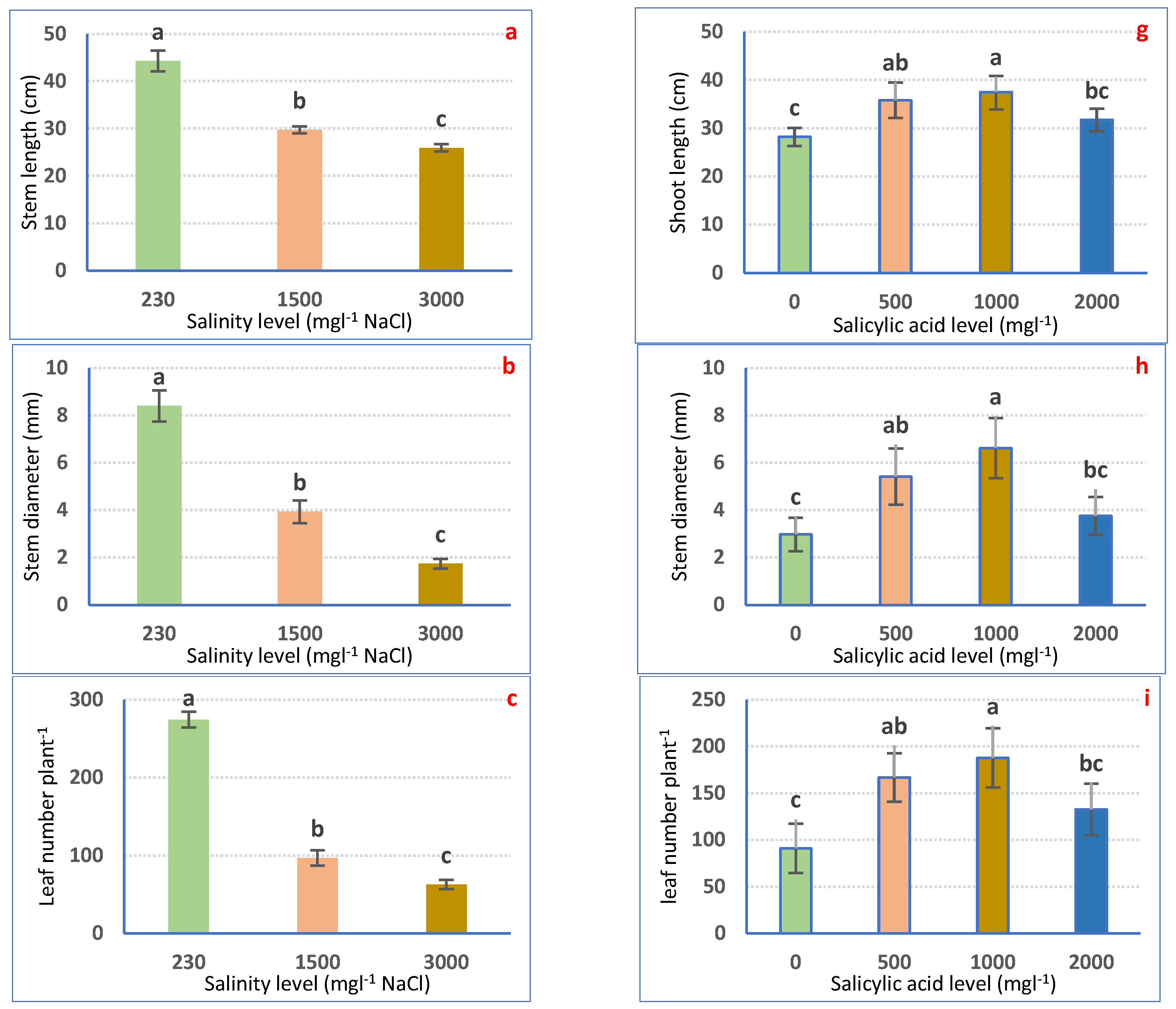
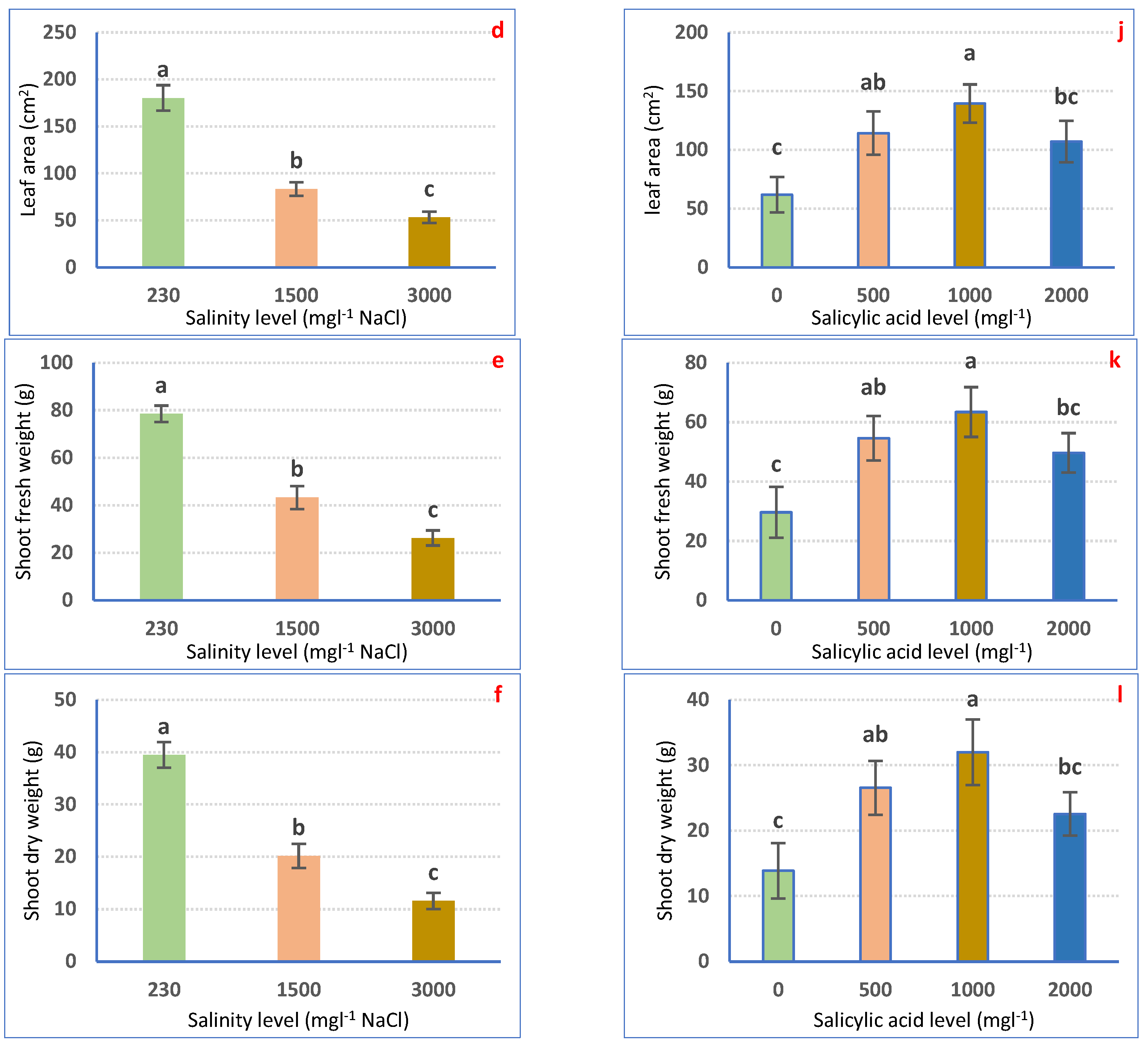
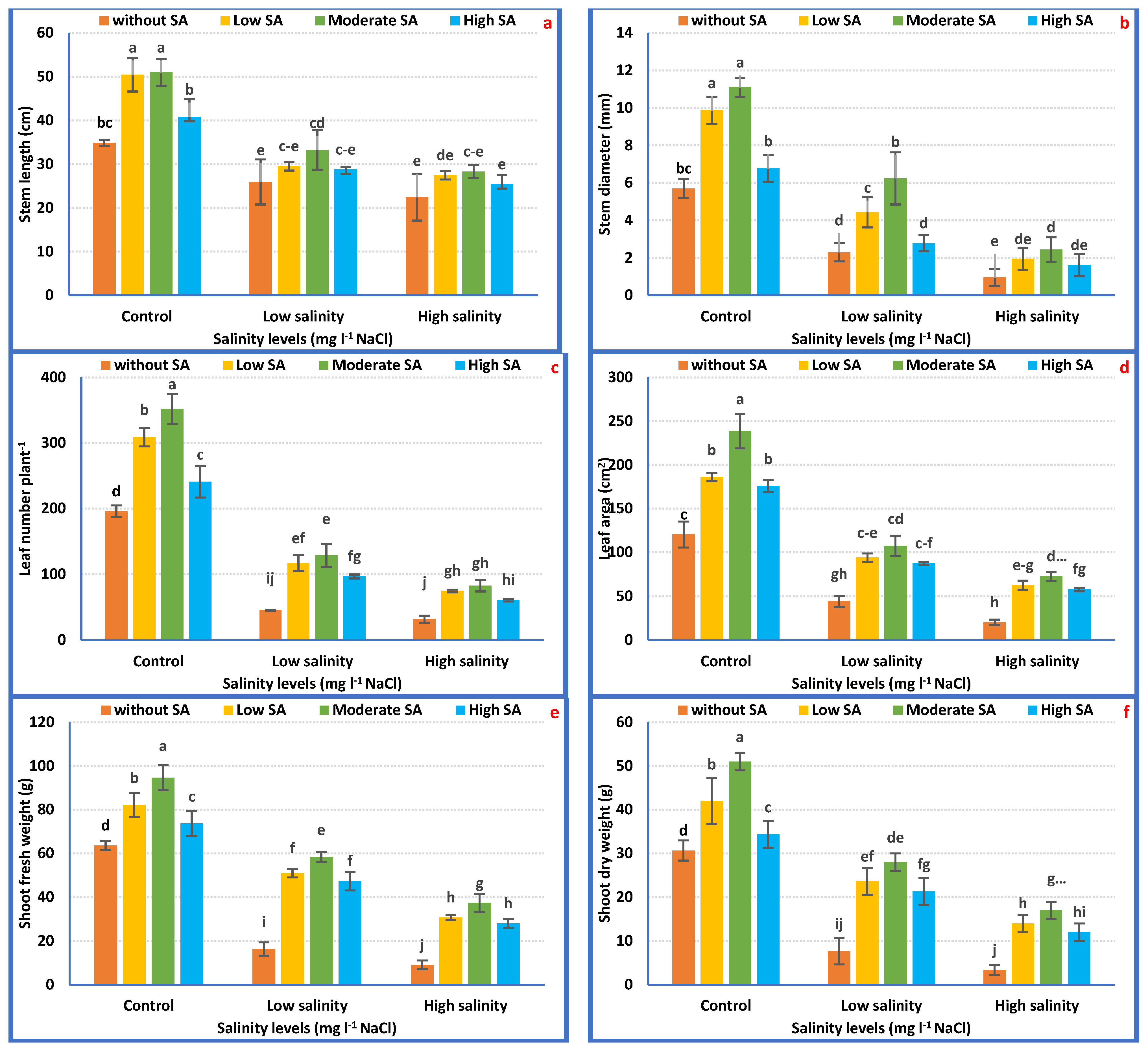
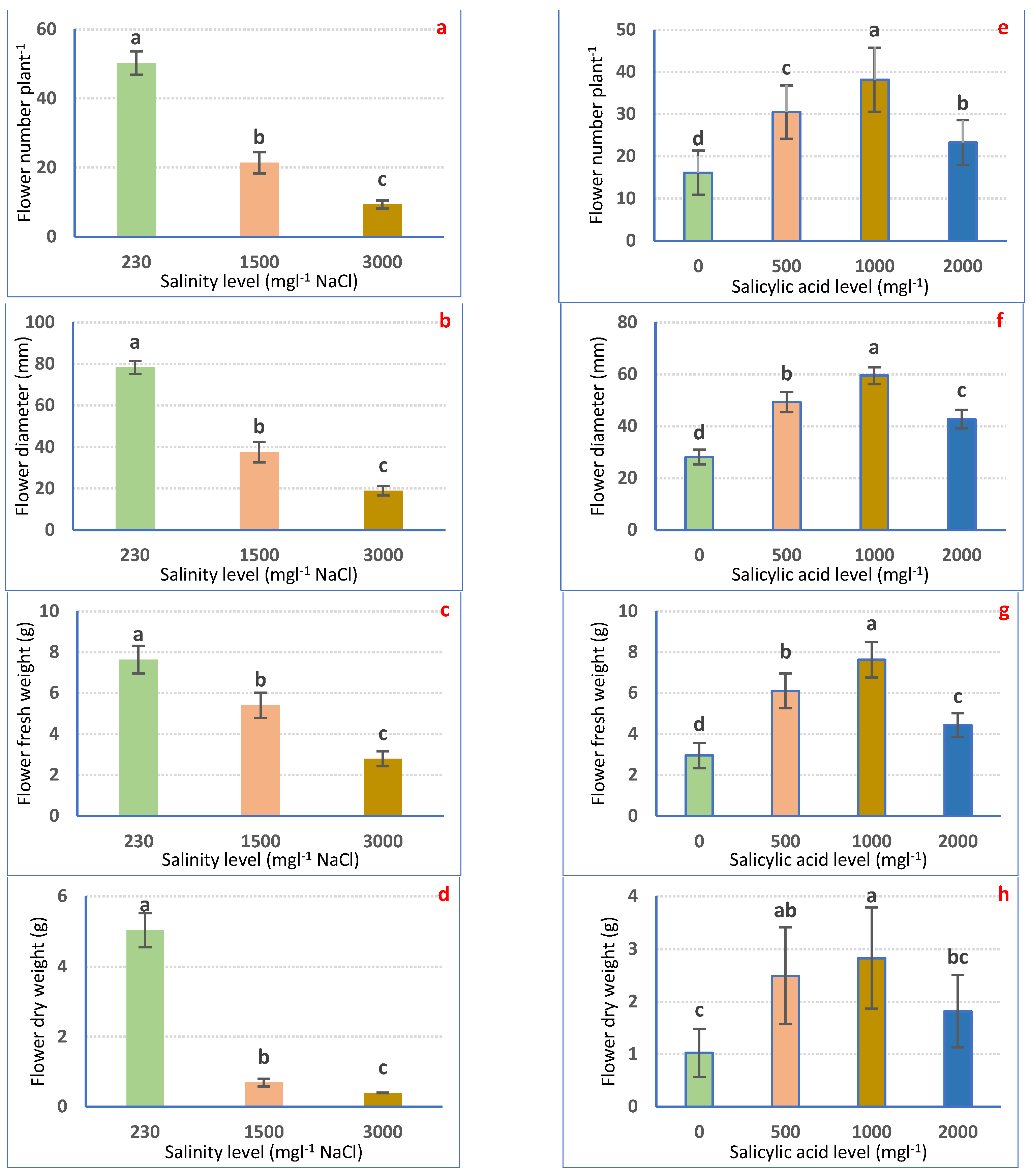
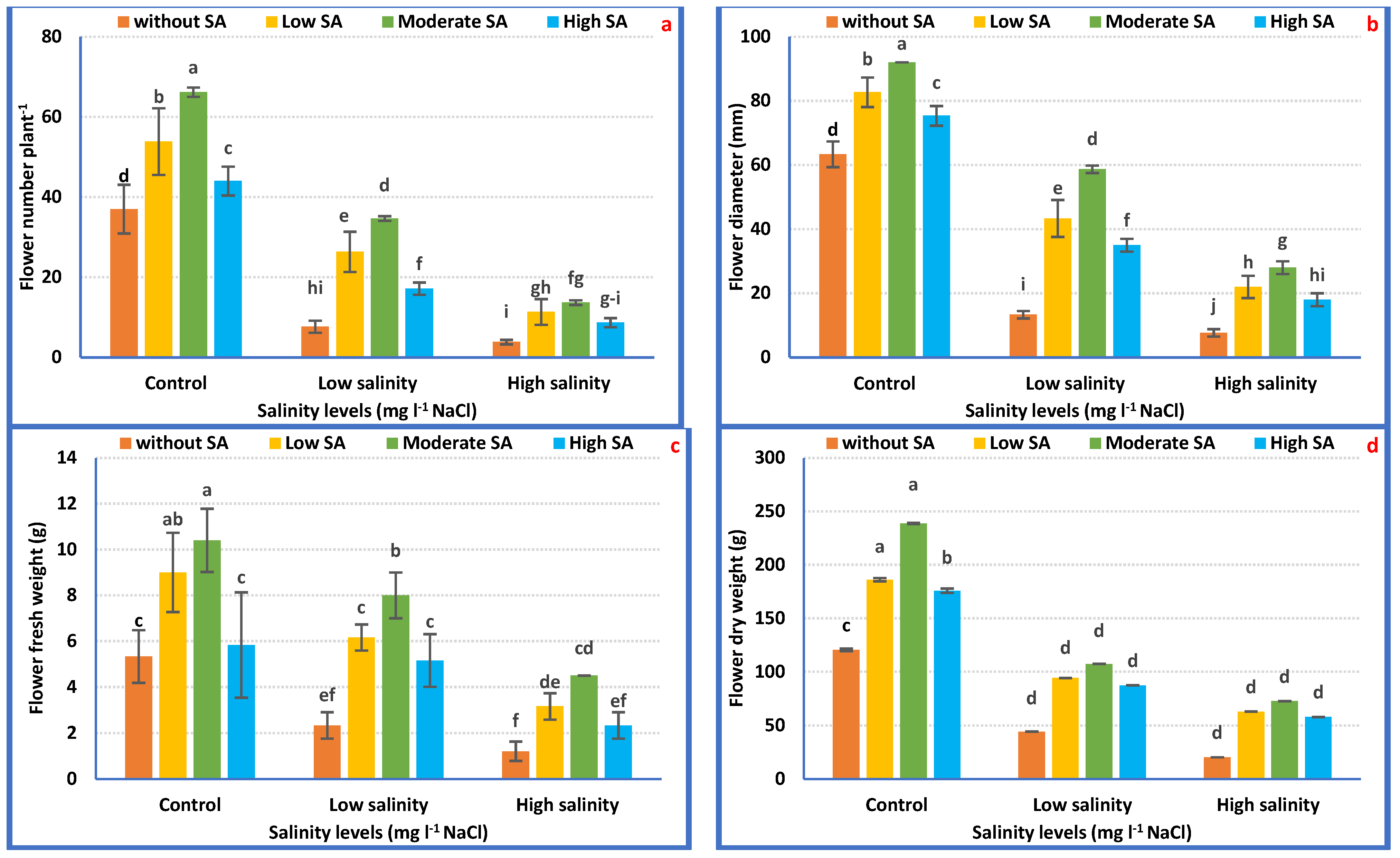
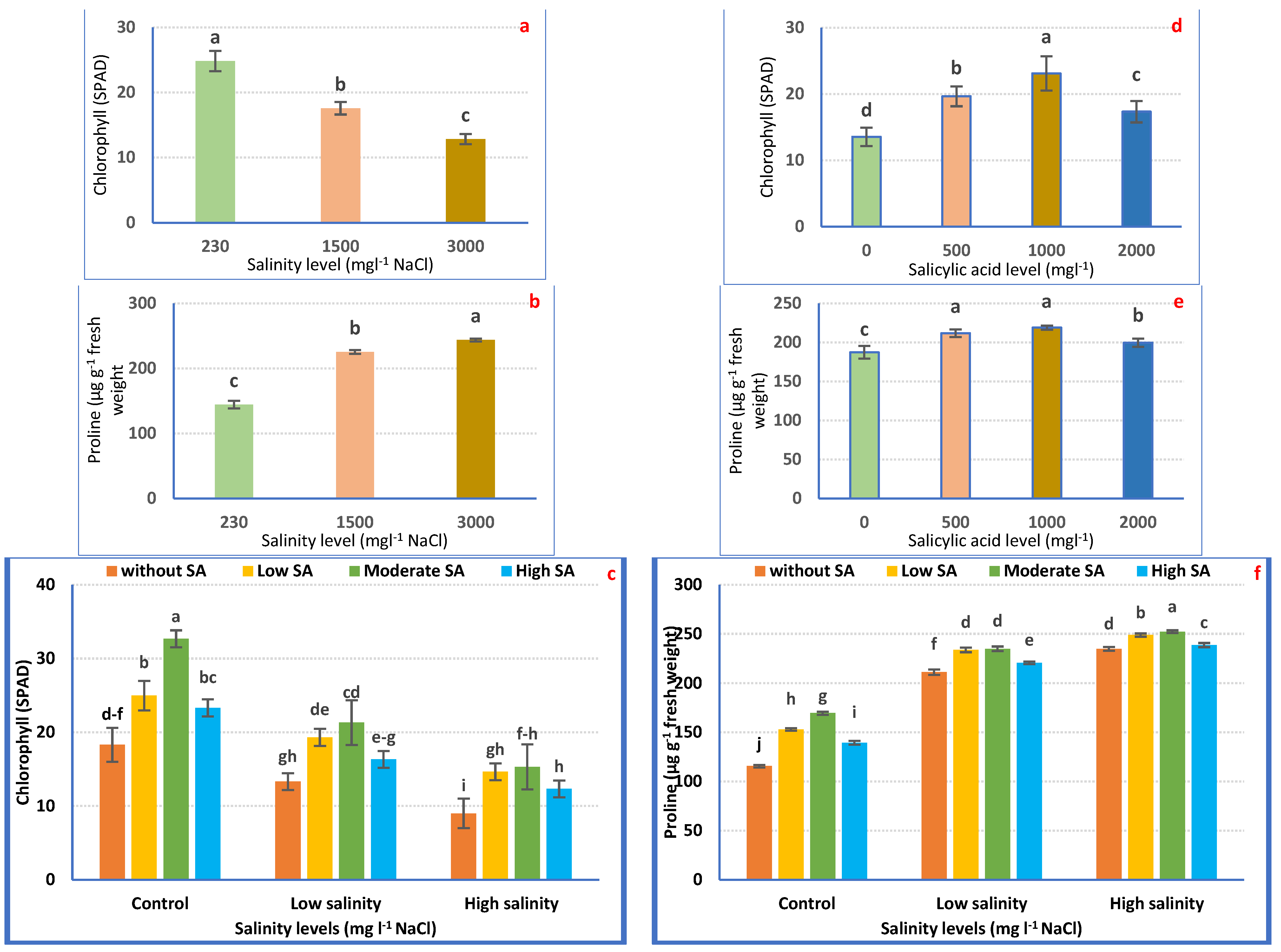
| Characteristics | Value | Characteristics | Value |
|---|---|---|---|
| Silt% | 88.1 | Cation exchange capacity (meq 100 g−1 soil) | 35.9 |
| Clay% | 8.80 | Organic matter% | 1.78 |
| Sand% | 3.02 | Available N (mg kg−1 soil) | 57.2 |
| pH | 7.62 | Available P (mg kg−1 soil) | 7.93 |
| EC (dSm−1) | 1.45 | Available potassium (mg kg−1 soil) | 120 |
| Bulk density (g cm3) | 1.42 |
| Treatments | Nitrogen | Phosphorus | Potassium | Calcium | Magnesium |
|---|---|---|---|---|---|
| NaCl salinity | |||||
| Control 230 mgL−1 (S0) | 363.4 ± 5.95 a | 80.59 ± 3.04 a | 484.6 ± 7.32 a | 48.75 ± 3.02 a | 47.69 ± 3.05 a |
| Low salinity 2000 mgL−1 (S1) | 260.1 ± 5.40 b | 75.66 ± 2.91 b | 321.5 ± 2.67 b | 35.06 ± 0.99 b | 34.62 ± 0.99 b |
| High salinity 4000 mgL−1 (S2) | 166.7 ± 8.83 c | 41.62 ± 1.44 c | 142.3 ± 7.24 c | 26.75 ± 2.49 c | 25.77 ± 2.50 c |
| p values | *** | *** | *** | *** | *** |
| Salicylic acid | |||||
| Without 0 mgL−1 (SA0) | 218.1 ± 28.62 c | 58.08 ± 3.76 b | 290.6 ± 5.33 c | 26.43 ± 2.34 c | 25.37 ± 3.49 c |
| Low concentration 500 mgL−1 (SA1) | 286.5 ± 31.83 a | 71.93 ± 6.97 a | 327.5 ± 5.38 a | 39.28 ± 2.89 b | 38.30 ± 3.01 b |
| Moderate concentration 1000 mgL−1 (SA2) | 295.9 ± 31.469 a | 74.66 ± 7.40 a | 338.0 ± 5.15 a | 45.65 ± 3.56 a | 44.67 ± 4.50 a |
| High concentration 2000 mgL−1 (SA3) | 253.2 ± 23.17 b | 59.16 ± 6.43 b | 308.5 ± 4.13 b | 36.76 ± 2.67 b | 35.77 ± 2.25 b |
| p values | *** | *** | *** | *** | *** |
| Interaction effects | |||||
| S0 + SA0 | 301.1 ± 16.12 bc | 68.46 ± 2.21 e | 455.9 ± 1.27 d | 35.56 ± 1.28 e | 34.29 ± 1.92 e |
| S0 + SA1 | 403.4 ± 2.26 a | 87.43 ± 1.89 b | 503.5 ± 2.30 b | 50.98 ± 1.55 b | 50.00 ± 1.56 b |
| S0 + SA2 | 415.1 ± 0.94 a | 93.16 ± 2.60 a | 513.3 ± 2.39 a | 63.22 ± 1.896 a | 62.23 ± 1.93 a |
| S0 + SA3 | 334.2 ± 2.31 b | 73.34 ± 1.82 d | 465.8 ± 0.90 c | 45.25 ± 1.98 c | 44.26 ± 2.04 c |
| S1 + SA0 | 236.1 ± 12.481 de | 62.24 ± 1.87 f | 313.4 ± 2.14 g | 31.16 ± 1.63 fg | 30.18 ± 1.53 fg |
| S1 + SA1 | 271.6 ± 14.26 cd | 84.26 ± 1.92 c | 324.4 ± 2.38 f | 35.96 ± 1.29 e | 34.97 ± 1.23 e |
| S1 + SA2 | 281.2 ± 1.84 cd | 85.41 ± 1.98 bc | 334.6 ± 2.64 e | 40.28 ± 2.11 d | 39.30 ± 2.09 d |
| S1 + SA3 | 251.7 ± 0.97 cd | 70.66 ± 1.34 de | 313.4 ± 2.83 g | 35.02 ± 1.42 e | 34.03 ± 1.47 e |
| S2 + SA0 | 117.2 ± 1.81 g | 43.48 ± 2.42 g | 102.5 ± 1.71 k | 12.64 ± 2.63 h | 11.63 ± 2.58 b |
| S2 + SA1 | 184..5 ± 0.92 f | 44.12 ± 1.11 g | 154.5 ± 2.45 i | 30.92 ± 0.59 g | 29.94 ± 0.58 fg |
| S2 + SA2 | 191.5 ± 1.36 ef | 45.41 ± 2.22 g | 165.9 ± 1.28 h | 33.45 ± 1.94 ef | 32.48 ± 1.91 ef |
| S2 + SA3 | 173.6 ± 2.11 f | 33.5 ± 1.61 b | 146.3 ± 1.76 j | 30.01 ± 1.24 g | 29.04 ± 1.26 g |
| p values | *** | *** | *** | *** | *** |
| Treatments | Manganese | Copper | Iron | Zinc | Sodium |
|---|---|---|---|---|---|
| NaCl salinity (mgl−1) | |||||
| Control 230 mgL−1 (S0) | 0.755 ± 0.008 a | 0.155 ± 0.009 a | 1.57 ± 0.030 a | 0.315 ± 0.012 a | 6.08 ± 0.27 c |
| Low salinity 2000 mgL−1 (S1) | 0.589 ± 0.034 b | 0.190 ± 0.008 b | 1.30 ± 0.019 b | 0.245 ± 0.006 b | 66.6 ± 3.21 b |
| High salinity 4000 mgL−1 (S2) | 0.458 ± 0.035 c | 0.077 ± 0.015 c | 0.440 ± 0.021 c | 0.149 ± 0.011 c | 76.0 ± 3.12 a |
| p values | *** | *** | *** | *** | *** |
| Salicylic acid | |||||
| Without 0 mgL−1 (SA0) | 0.498 ± 0.058 c | 0.107 ± 0.018 c | 0.93 ± 0.203 b | 0.205 ± 0.023 c | 61.4 ± 11.53 a |
| Low concentration 500 mgL−1 (SA1) | 0.646 ± 0.038 b | 0.158 ± 0.010 b | 1.08 ± 0.198 b | 0.254 ± 0.029 b | 46.4 ± 10.26 b |
| Moderate concentration 1000 mgL−1 (SA2) | 0.712 ± 0.024 a | 0.190 ± 0.014 a | 1.39 ± 0.081 a | 0280 ± 0.021 a | 42.2 ± 9.49 b |
| High concentration 2000 mgL−1 (SA3) | 0.546 ± 0.054 c | 0.108 ± 0.024 c | 1.00 ± 0.209 b | 0.206 ± 0.023 c | 48.2 ± 10.55 b |
| p values | *** | *** | *** | *** | *** |
| Interaction effects | |||||
| S0 + SA0 | 0.726 ± 0.011 b | 0.126 ± 0.011 e | 1.43 ± 0.03 cd | 0.27 ± 0.02 b | 7.46 ± 0.24 g |
| S0 + SA1 | 0.773 ± 0.030 ab | 0.16 ± 0.02 d | 1.64 ± 0.02 ab | 0.353 ± 0.011 a | 5.44 ± 0.33 gh |
| S0 + SA2 | 0.786 ± 0.011 a | 0.206 ± 0.023 ab | 1.68 ± 0.13 a | 0.36 ± 0.02 a | 5.17 ± 0.54 h |
| S0 + SA3 | 0.736 ± 0.030 b | 0.13 ± 0.02 e | 1.53 ± 0.03 bc | 0.28 ± 0.02 b | 6.26 ± 0.11 gh |
| S1 + SA0 | 0.43 ± 0.04 e | 0.16 ± 0.02 d | 1.25 ± 0.04 ef | 0.23 ± 0.02 c | 83.3 ± 1.70 b |
| S1 + SA1 | 0.656 ± 0.04 c1 | 0.19 ± 0.011 bc | 1.30 ± 0.03 e | 0.26 ± 0.02 b | 64.4 ± 1.99 e |
| S1 + SA2 | 0.726 ± 0.03 b | 0.23 ± 0.02 a | 1.36 ± 0.02 de | 0.27 ± 0.02 b | 53.7 ± 1.05 f |
| S1 + SA3 | 0.543 ± 0.046 d | 0.18 ± 0.02 cd | 1.30 ± 0.24 e | 0.22 ± 0.02 c | 65.1 ± 2.35 e |
| S2 + SA0 | 0.34 ± 0.034 f | 0.036 ± 0.011 f | 0.13 ± 0.02 h | 0.116 ± 0.01 e | 93.5 ± 2.12 a |
| S2 + SA1 | 0.51 ± 0.034 d | 0.123 ± 0.011 e | 0.32 ± 0.02 g | 0.15 ± 0.02 d | 69.3 ± 1.99 d |
| S2 + SA2 | 0.623 ± 0.011 c | 0.133 ± 0.011 e | 1.13 ± 0.02 f | 0.21 ± 0.02 c | 67.9 ± 1.11 d |
| S2 + SA3 | 0.36 ± 0.04 f | 0.016 ± 0.011 f | 0.18 ± 0.02 h | 0.12 ± 0.02 e | 73.2 ± 1.59 c |
| p values | *** | *** | *** | *** | *** |
Disclaimer/Publisher’s Note: The statements, opinions and data contained in all publications are solely those of the individual author(s) and contributor(s) and not of MDPI and/or the editor(s). MDPI and/or the editor(s) disclaim responsibility for any injury to people or property resulting from any ideas, methods, instructions or products referred to in the content. |
© 2023 by the authors. Licensee MDPI, Basel, Switzerland. This article is an open access article distributed under the terms and conditions of the Creative Commons Attribution (CC BY) license (https://creativecommons.org/licenses/by/4.0/).
Share and Cite
Elhindi, K.M.; Almana, F.A.; Al-Yafrsi, M.A. Morpho-Biochemical Modification of Petunia to Saline Water and Salicylic Acid Applications. Horticulturae 2023, 9, 1197. https://doi.org/10.3390/horticulturae9111197
Elhindi KM, Almana FA, Al-Yafrsi MA. Morpho-Biochemical Modification of Petunia to Saline Water and Salicylic Acid Applications. Horticulturae. 2023; 9(11):1197. https://doi.org/10.3390/horticulturae9111197
Chicago/Turabian StyleElhindi, Khalid M., Fahed A. Almana, and Mohammed A. Al-Yafrsi. 2023. "Morpho-Biochemical Modification of Petunia to Saline Water and Salicylic Acid Applications" Horticulturae 9, no. 11: 1197. https://doi.org/10.3390/horticulturae9111197
APA StyleElhindi, K. M., Almana, F. A., & Al-Yafrsi, M. A. (2023). Morpho-Biochemical Modification of Petunia to Saline Water and Salicylic Acid Applications. Horticulturae, 9(11), 1197. https://doi.org/10.3390/horticulturae9111197





